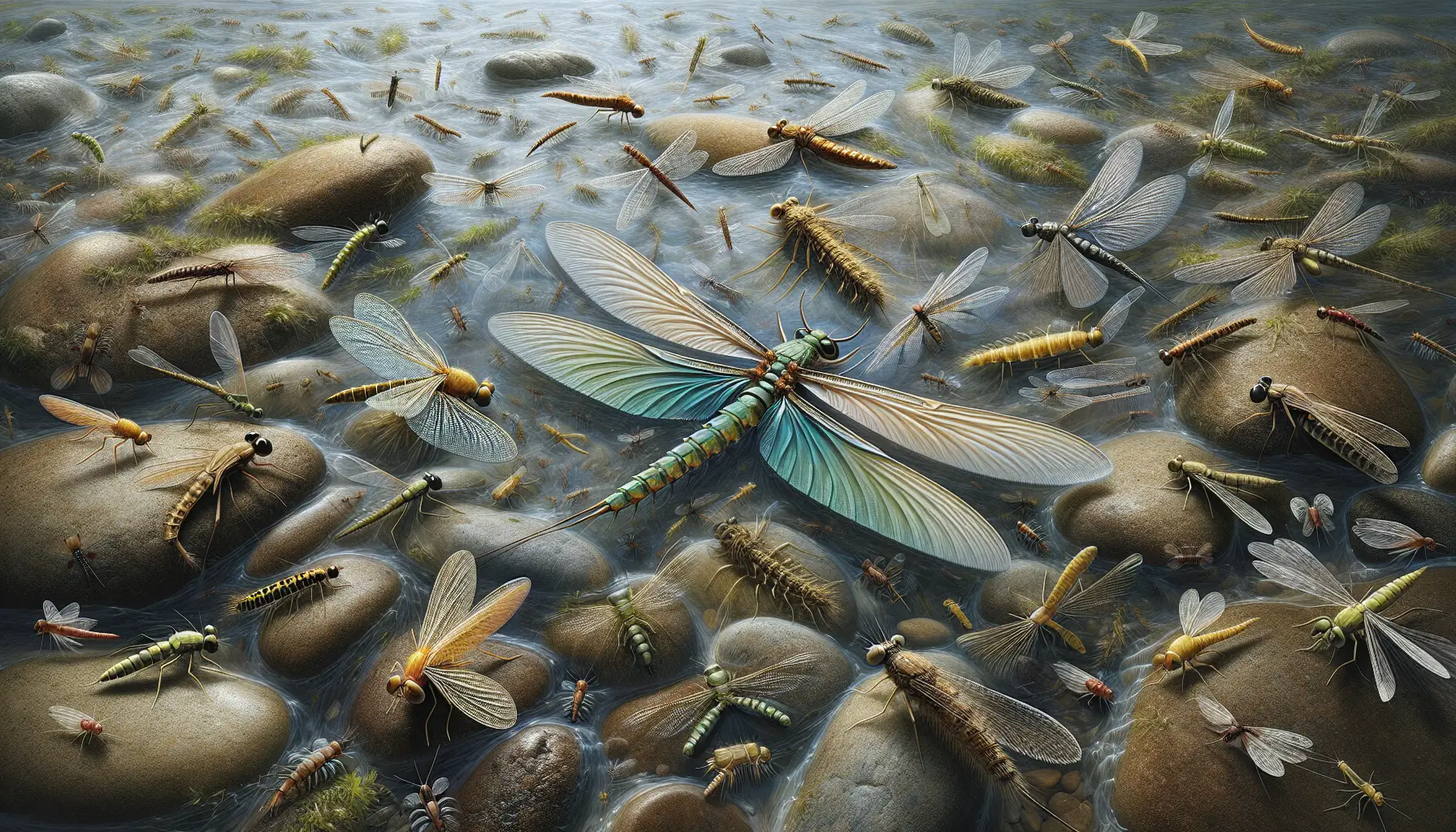Understanding Fish Behavior
Getting a handle on fish habits is a game-changer for anyone into fly fishing. Turns out, those little wigglers, aka aquatic insects in streams, play a pretty big role in how fish behave. Oh, and let’s not forget the wild card—climate change—that’s shaking things up in the fish’s watery hood.
The Buzz About Aquatic Insects
Aquatic insects are the unsung heroes in stream communities. They’re like the janitors, chefs, and life coaches all rolled into one for the entire ecosystem. They chow down on muck, keep the water spic ‘n span, and are basically the fish’s buffet (CAES Newswire).
Here’s the skinny on how bugs and fish interrelate:
- Nutrient Nannies: Bugs break down dead stuff, turning it into nutrients that freshen up the water.
- Clearing the Mess: Eating debris and algae, they ensure the water is clearer than your grandma’s prized crystal.
- All You Can Eat: Bugs are on the menu every day; fish love munching on them in various life phases.
Fish love to hang out where bugs are bustling, usually in those bubbled-up spots like riffles and pools. Knowing the types of bugs hanging around and their growth phases can turn your fly choices into fish magnets.
| Aquatic Insect | Life Stage Hangout | Fish Chill Behavior |
|---|---|---|
| Mayflies | Nymph, Emerger, Adult | Trout treat themselves on nymphs and emergers. |
| Caddisflies | Larva, Pupa, Adult | Fish prefer larvae and pupae in fast waters. |
| Stoneflies | Nymph, Adult | Nymph hunting near rocks is a fish sport. |
| Midges | Larva, Pupa, Adult | Sought by fish in calm waters. |
The Climate Shuffle
Mother Nature’s mood swings, aka climate change, are throwing insect life into a chaotic party, messing with the whole fish-pond scene. With shifts in temperature, rainfall, and stream flows, insect schedules go haywire, which means fish chow time gets weird too.
Experts like Darold Batzer are diving into this chaos to make sense of it for the rest of us (CAES Newswire). Things like warmer temps and water flow changes due to dams stand-in the way of insect life highs and fish feeding lows. Anglers need to be quick to adjust their approach to catch the wave of changes.
| Climate Factor | Bug Impact | Fish Style Shift |
|---|---|---|
| Warm Up | Quicker hatching bugs | Fish meals come earlier, catch up! |
| Twisted Water Flow | Life interrupted | Fish go food-hunting elsewhere. |
| Rain Dance | Bug numbers on rollercoaster | Fish meals get more unpredictable. |
Being clued-up on how bugs and climate shifts mess with fish actions lets anglers make savvy choices on the riverbank. Keeping tabs on the buzz and the changes will not only up your fishing game but also create a bond with the watery world.
Importance of Bugs in Streams
Stream bugs aren’t just water-loving critters; they’re like nature’s little superheroes, keeping things in balance. They’re also great at giving us the heads-up about stream health. Let’s jump into how important they are to these watery habitats and why they’re good at telling us how the stream’s doing.
How Bugs Help Out
These bugs, especially when they’re just little larvae, are key players in the food game of streams. For a lot of fish, like trout and other fish people like to catch, they’re what’s for dinner. By munching on stuff like algae and decaying leaves, they help keep nutrients and energy zipping through the stream in the right way.
- Food Chain: Both baby and grown-up bugs are tasty snacks for fish and other animals, making them vital in keeping the whole food thing going.
- Recycling Nutrients: They play a huge part in breaking down dead stuff, which helps recycle the good stuff in the water.
- Home Improvement: By digging and munching, they change up the streambed. This helps keep the mud aired out and the water clean.
Bugs That Tell Us How Streams Are Doing
These bugs don’t just hang out in streams for fun; they’re like the stream’s report card. Some are super picky about clean water and good living conditions, so they’re like a natural way to check the stream’s health.
| Bug Type | Pollution Sensitivity | What Their Presence Means |
|---|---|---|
| Mayflies | Very picky | Water that’s clean and packed with oxygen |
| Stoneflies | Very picky | Cold, rushing water and low pollution |
| Caddisflies | Somewhat picky | Streams that aren’t too wacky, but can handle some grime |
| Midges | Not so picky | OK with grubby water |
Source: Smithsonian Environmental Research Center
- Mayflies: These gentle bugs like chill, clean streams. If they’re around, that’s a good sign. If they’re not, it might mean things are getting grimy.
- Stoneflies: They love fast, fresh, moving water. Spot them, and you’re looking at a near-perfect stream.
- Caddisflies: These bugs are flexible but still good markers of stable streams.
- Midges: Fine with dirty water, so if they’re all you see, the water isn’t in the best shape.
Keeping streams in good shape takes more than just cutting out the pollution. It’s about protecting stream edges from washing away, handling strong currents during storms, and dealing with hard surfaces like roads that mess with water flow. Even just 2% of roads and pavements can mess things up for these water habitats (Smithsonian Environmental Research Center).
Researchers use cool tech like underwater cameras and bug studies to keep tabs on these stream heroes. Volunteer citizens also help out by getting hands-on with stream restoration work (Smithsonian Environmental Research Center).
Fly anglers, by understanding how important these water bugs are and what they tell us, can not only enjoy successful fishing trips but also play their part in keeping local waters healthy.
Life Cycles of Major Aquatic Insects
Mayflies and Stoneflies
Mayflies and stoneflies are like the secret sauce in a fish’s diet. Knowing their life cycles can give fly fishermen an edge out on the water.
Mayflies
Mayflies are like the transformers of the bug world, going through a funky life cycle. They start as tiny eggs that morph into nymphs (or naiads if we’re gettin’ fancy) under water. Then they emerge as sub-adults (duns) and finally strut their stuff as adult spinners. During their nymph days, they’re full time aquatic, living it up below the water’s top:
| Stage | Description |
|---|---|
| Egg | Dropped into water, these hatch into nymphs. |
| Nymph (Naiad) | Aquatic phase where they feed and grow. |
| Sub-adult (Dun) | Here’s where it gets exciting—they pop outta the water, wings in the making, not interested in chow. |
| Adult (Spinner) | It’s party and goodbye! They mate, lay eggs, and wrap it up in no time. |
Source: The Scientific Fly Angler
Stoneflies
Stoneflies are kind of like mayflies, but with their own swagger. They too skip the cocoon gig and just keep it simple, dragging out their nymph stage a bit longer. Here’s the scoop for those casting lines with enthusiasm:
| Stage | Description |
|---|---|
| Egg | Laid in streams, turning into bustling nymphs. |
| Nymph | Nymph life goes long and strong—these guys grow for months or even years! |
| Adult | Final phase’s all about love and legacy, sticking around streams but not for long. |
Caddisflies and Midges
Caddisflies and midges, unlike our previous insect buddies, go all out with a full-blown metamorphosis. They’re all about egg, larva, pupa, and adult stages, making them a big deal in trout hangouts.
Caddisflies
Caddisflies are those creative types, always switching up their look. Anglers need to be sharp to imitate their moves:
| Stage | Description |
|---|---|
| Egg | Dropped in water, these hatch into little architects called larvae. |
| Larva | They get crafty here, using bits of stuff around them to build cozy cases. |
| Pupa | It’s a makeover—dressing up for the adult world inside their safe bubble. |
| Adult | They pop by streams often, simply focused on hooking up. |
Source: The Scientific Fly Angler
Midges
Midges may be tiny, but they sure know how to throw a winter bug bash. Knowing their life cycle helps fishers cook up better lures:
| Stage | Description |
|---|---|
| Egg | Laid in clusters on water tops—just hanging around. |
| Larva | Aquatic munchers, feasting on organic tidbits. |
| Pupa | The cool, mysterious phase happening in water. |
| Adult | Delicate and crucial on fish menus, especially in chilly weather. |
Grasping these bug timelines gives fly anglers the know-how to outsmart the fish. Gettin’ these nests matched right amps up fishing skills.
Practical Entomology for Fly Fishing
If you’re into fly fishing, getting a grip on stream bugs can shoot your fishing game through the roof. Nail the art of imitating the right insect and you’ll be the champ of the river.
Matching Insect Species
Gone fishin’? Don’t forget the hatch. Match those insects popping out or buzzing around the stream, and you’re already halfway to a catch. Aquatic critters like mayflies, stoneflies, caddis, and midges go through all sorts of stages: nymphs, adults, you name it.
Packing a bunch of fly lookalikes in different sizes, shapes, and colors is smart. It’s all about being ready to mimic those natural stream buddies.
| Insect Type | Life Stage | Recommended Fly |
|---|---|---|
| Mayflies | Nymph | Pheasant Tail Nymph |
| Stoneflies | Emerger | Yellow Sally Emerger |
| Caddisflies | Pupa | Copper John |
| Midges | Imago | Zebra Midge |
Ever tried a Yellow Stone Fly Nymph in Montana? Folks have snagged some browns over 17 inches on the Clark’s Fork River with that trick in July (Fly Fisherman). No joke.
Nymph Fishing Techniques
Getting fish that lurk under the surface? Nymph fishing’s your friend. Just a few tricks can make all the difference.
-
Longer Leader Lengths: A longer leader digs deeper, and that’s where the fish are chilling. Jim Quick, in his book “Fishing the Nymph,” suggests swapping a 9-foot leader for a 12-foot one (Fly Fisherman). Helps your nymph glide just right.
-
Indicator Use: Using a strike indicator lets you know when the fish are biting. No more guessing – you’ll be on top of things fast.
-
Weighted Nymphs: Weighted flies or adding a bit of split shot gets those flies down deep in a hurry, which is ace for rapid waters.
Master these nymph techniques and match those bugs spot-on, and you’ll be reeling them in like a pro. Finding out how these water bugs behave helps you angle better, turning every fishing trip into a sweet adventure.

